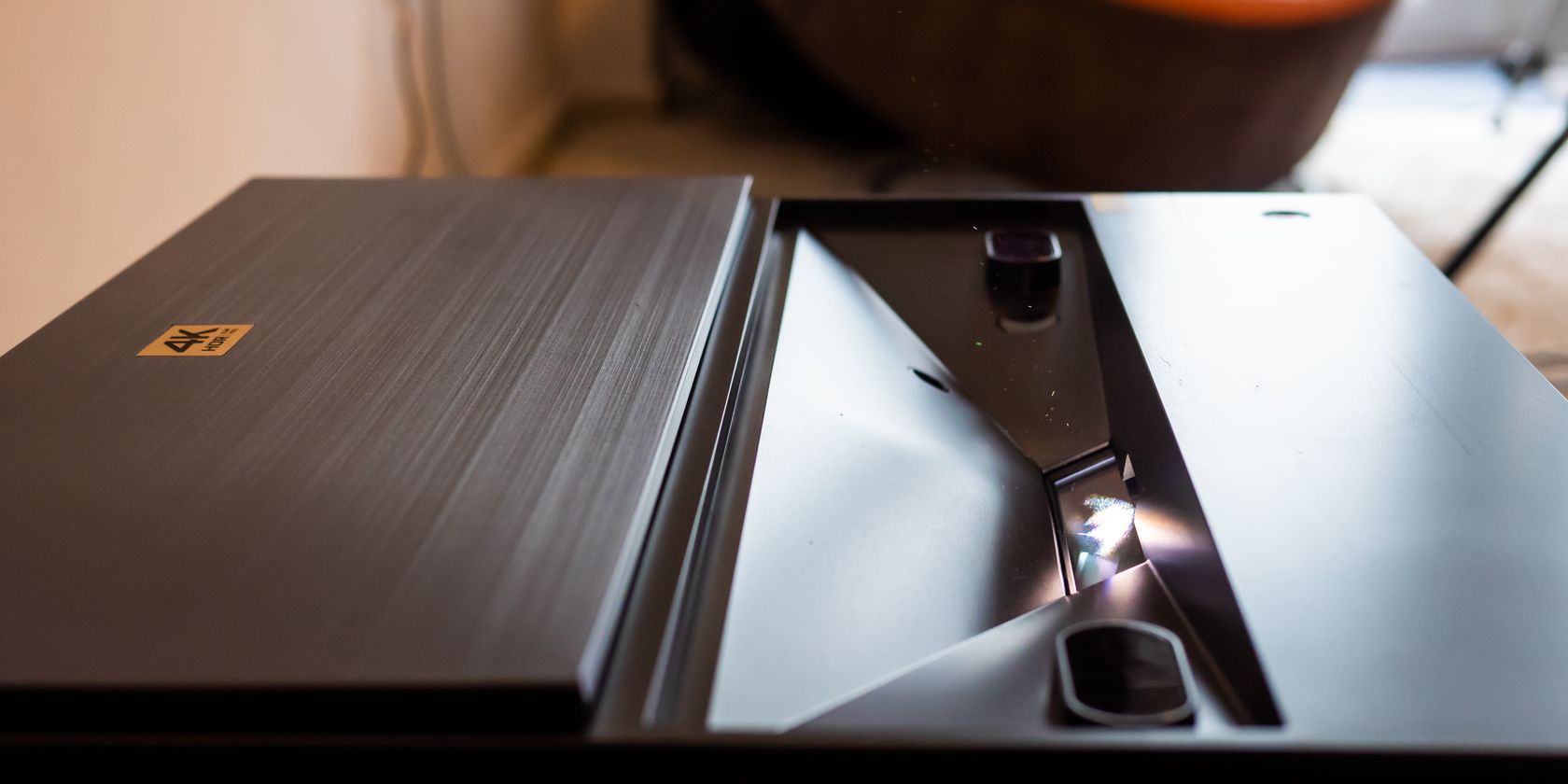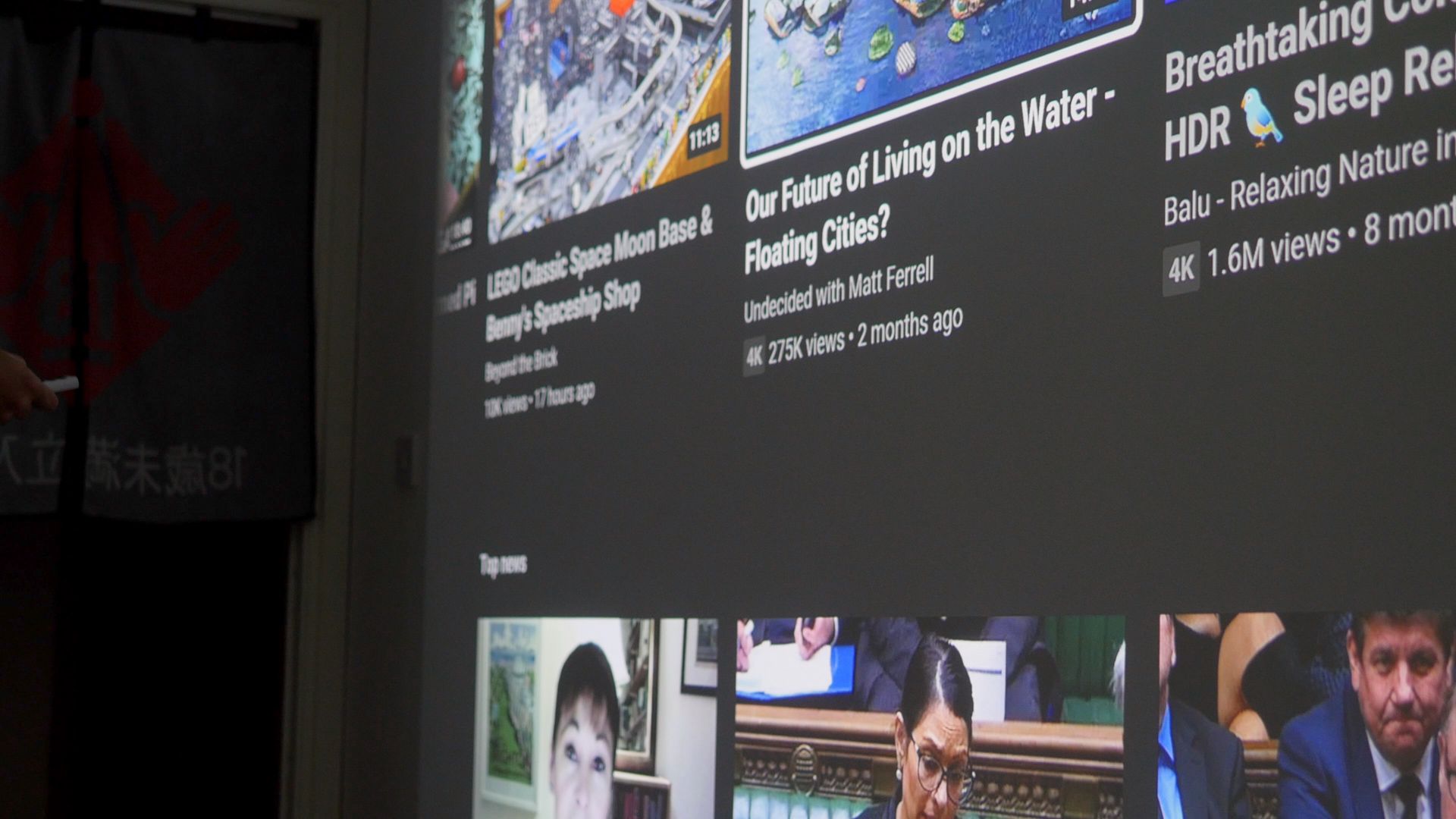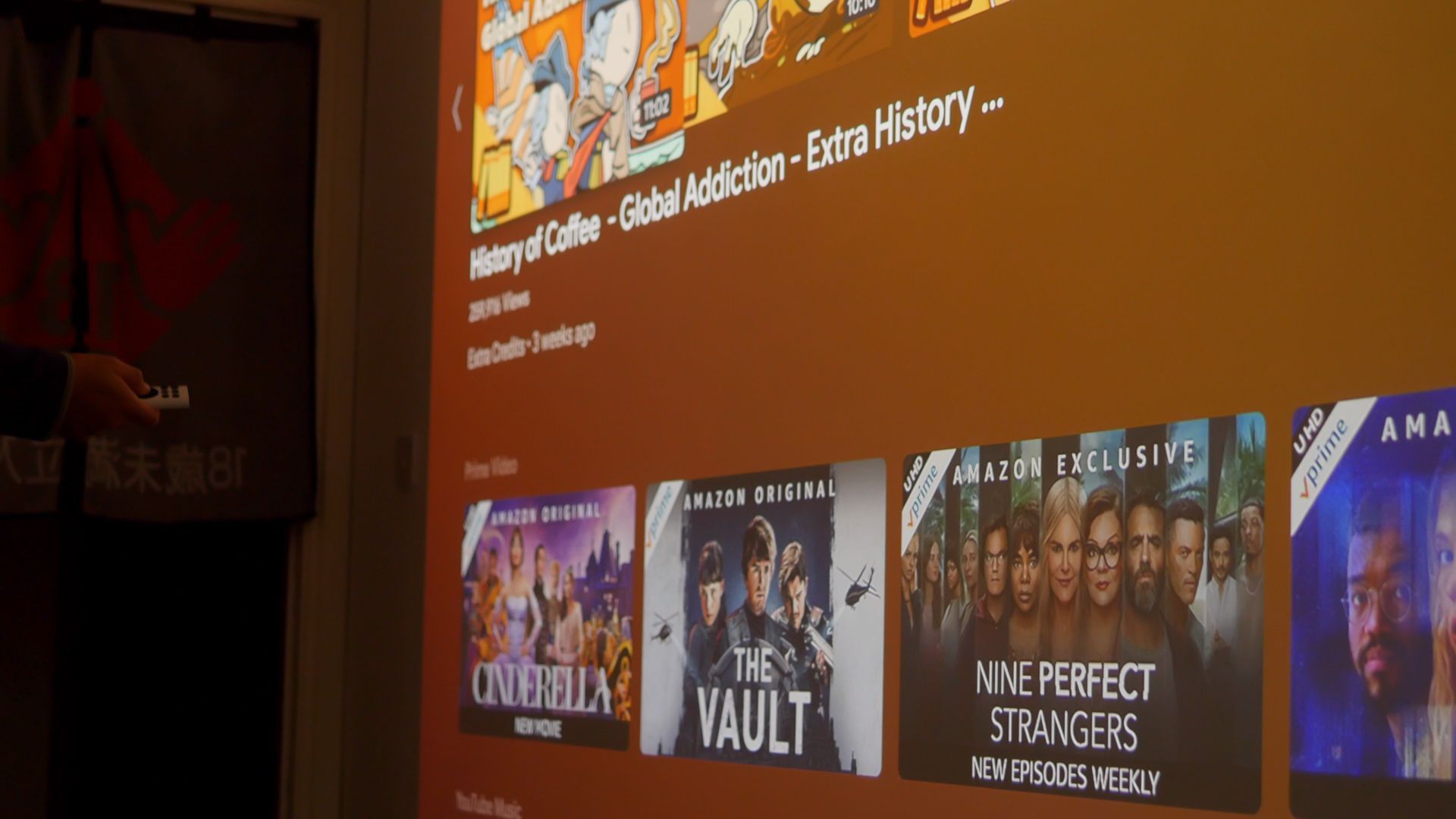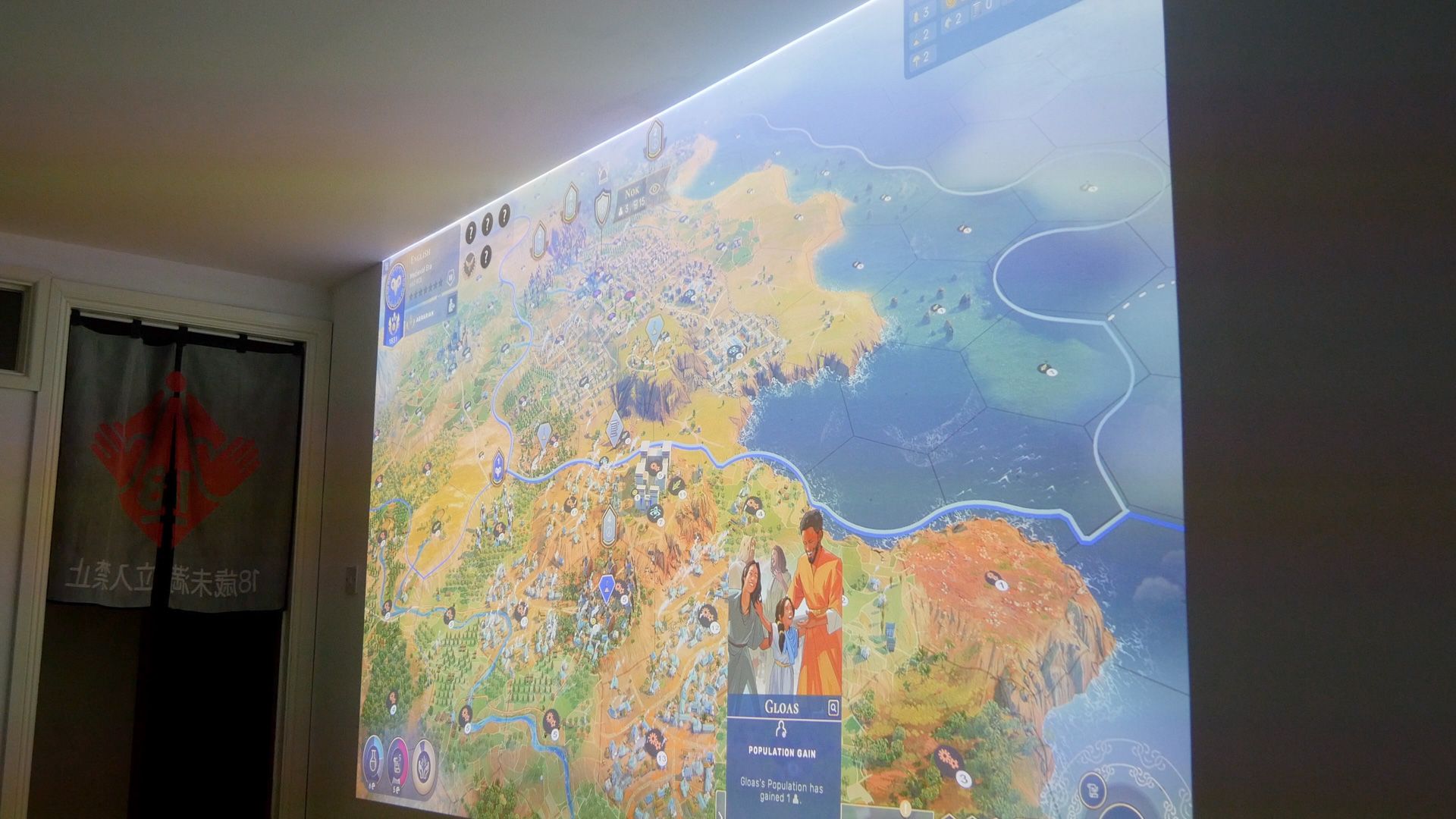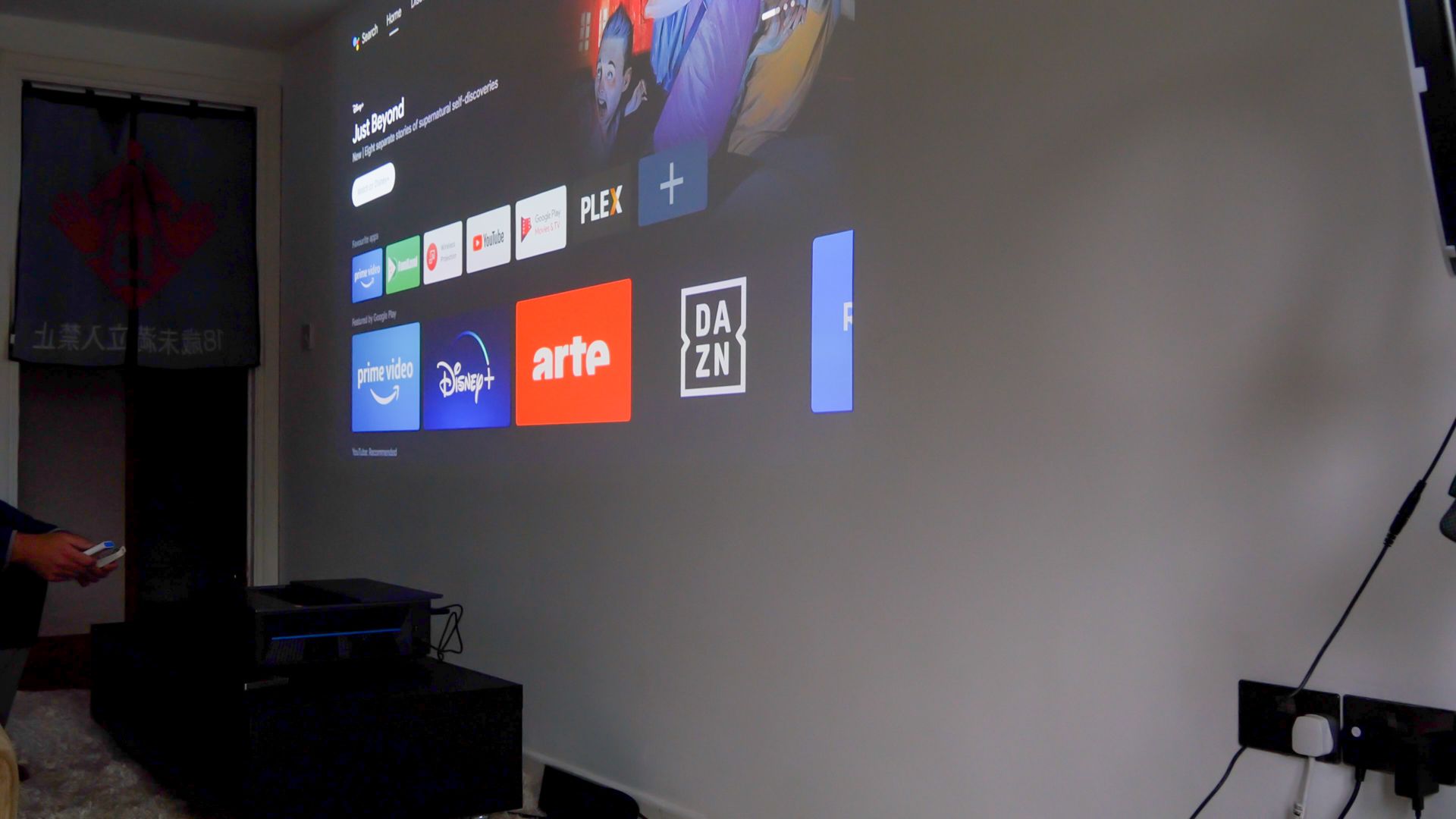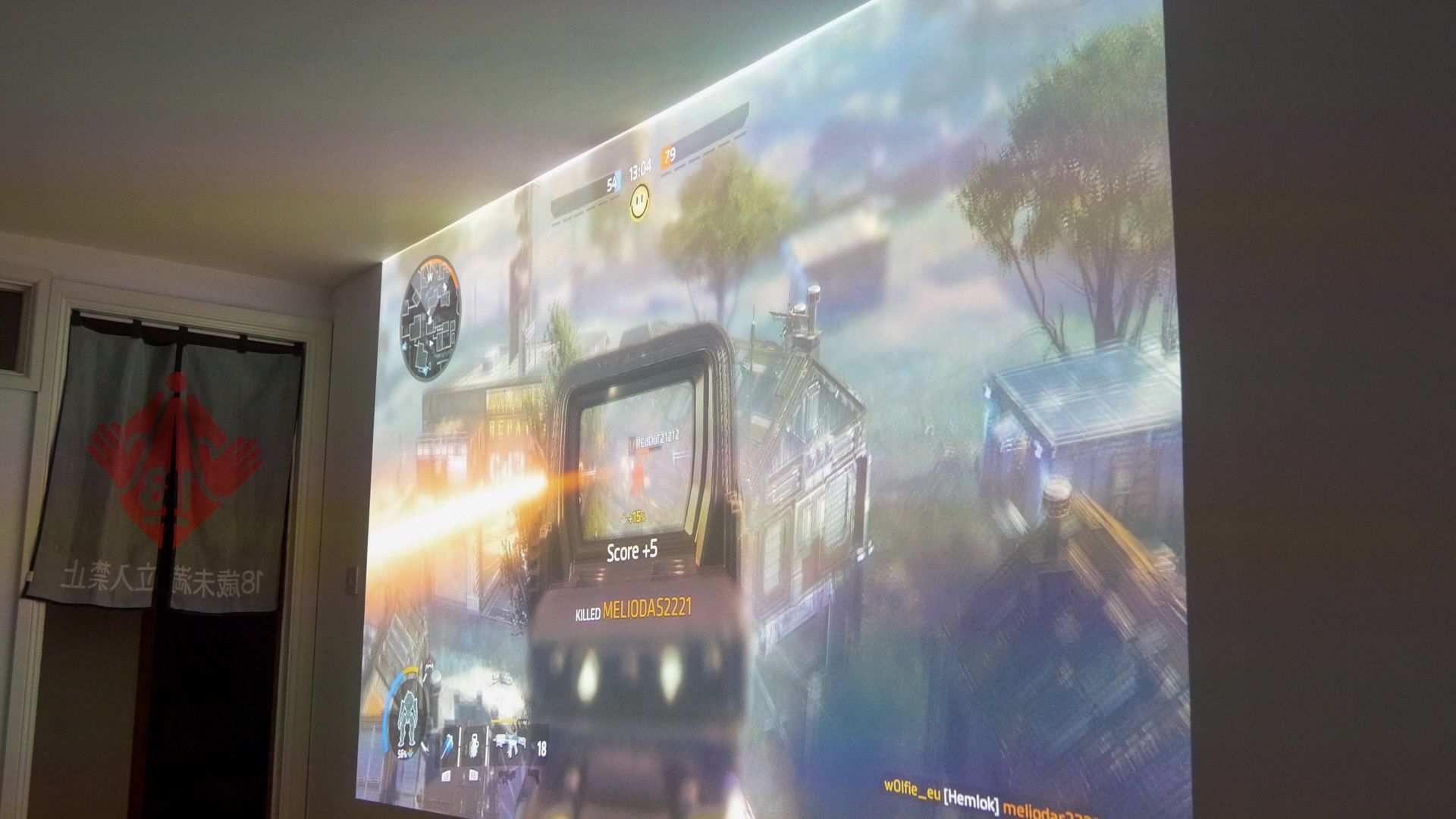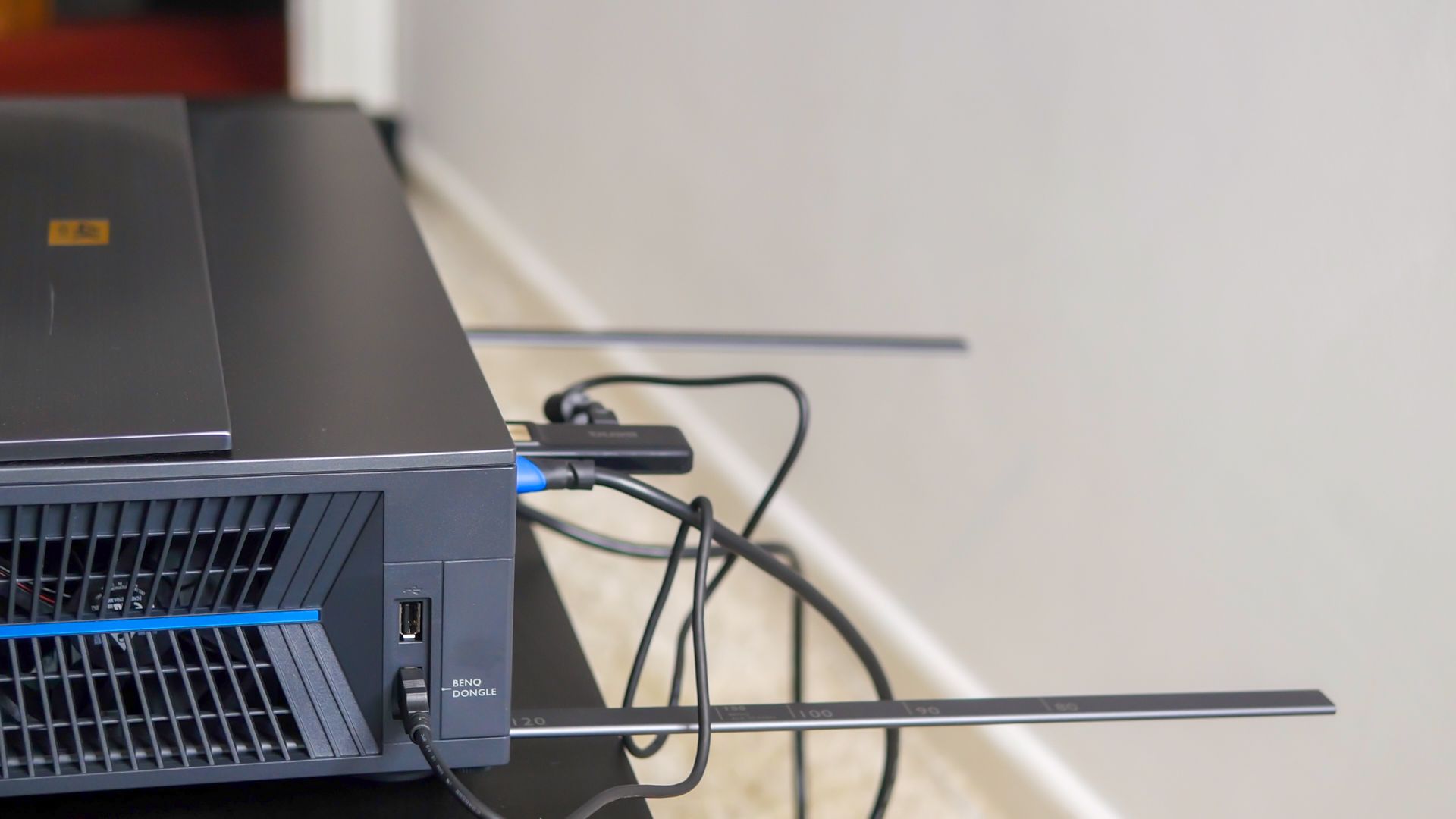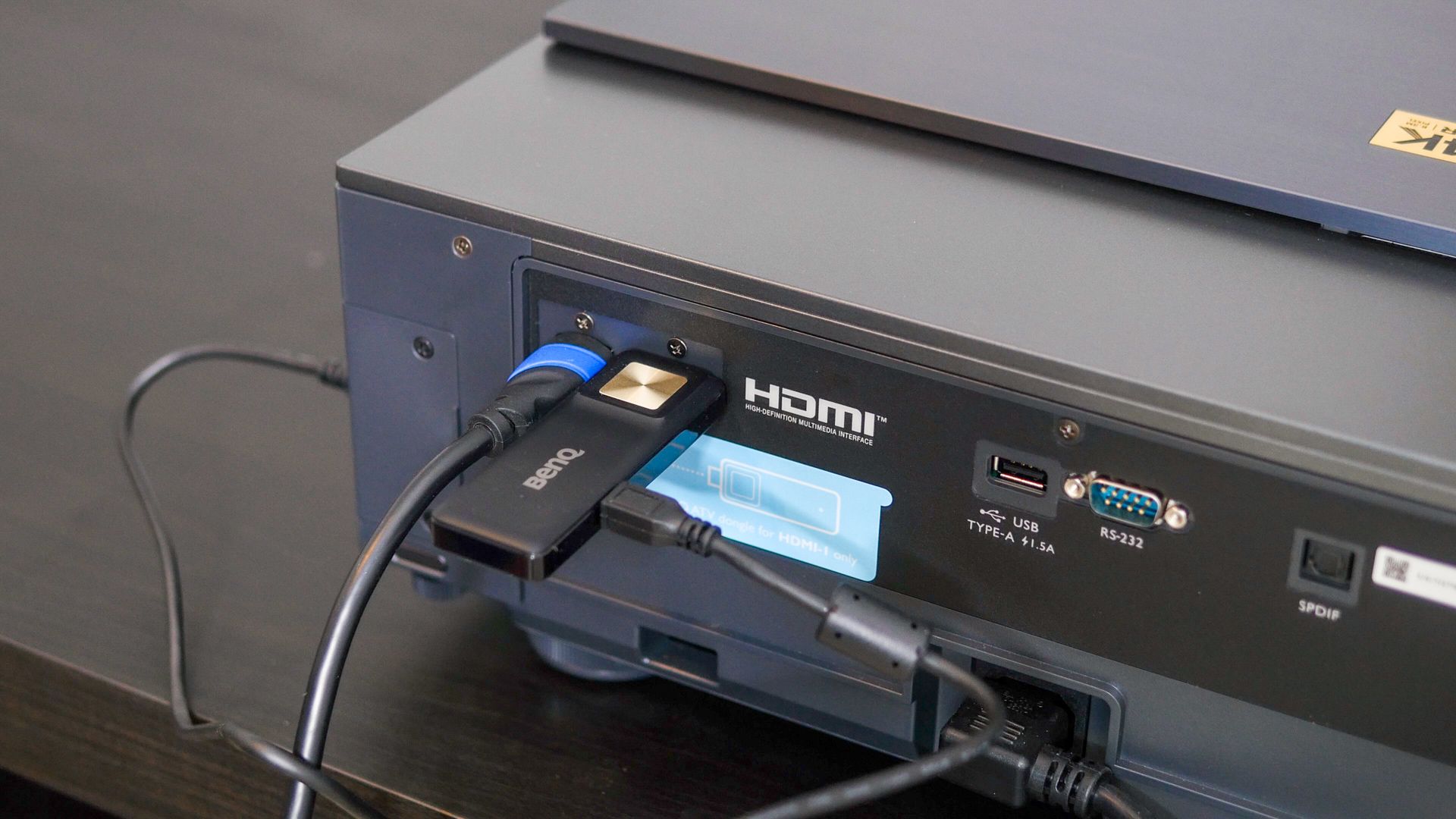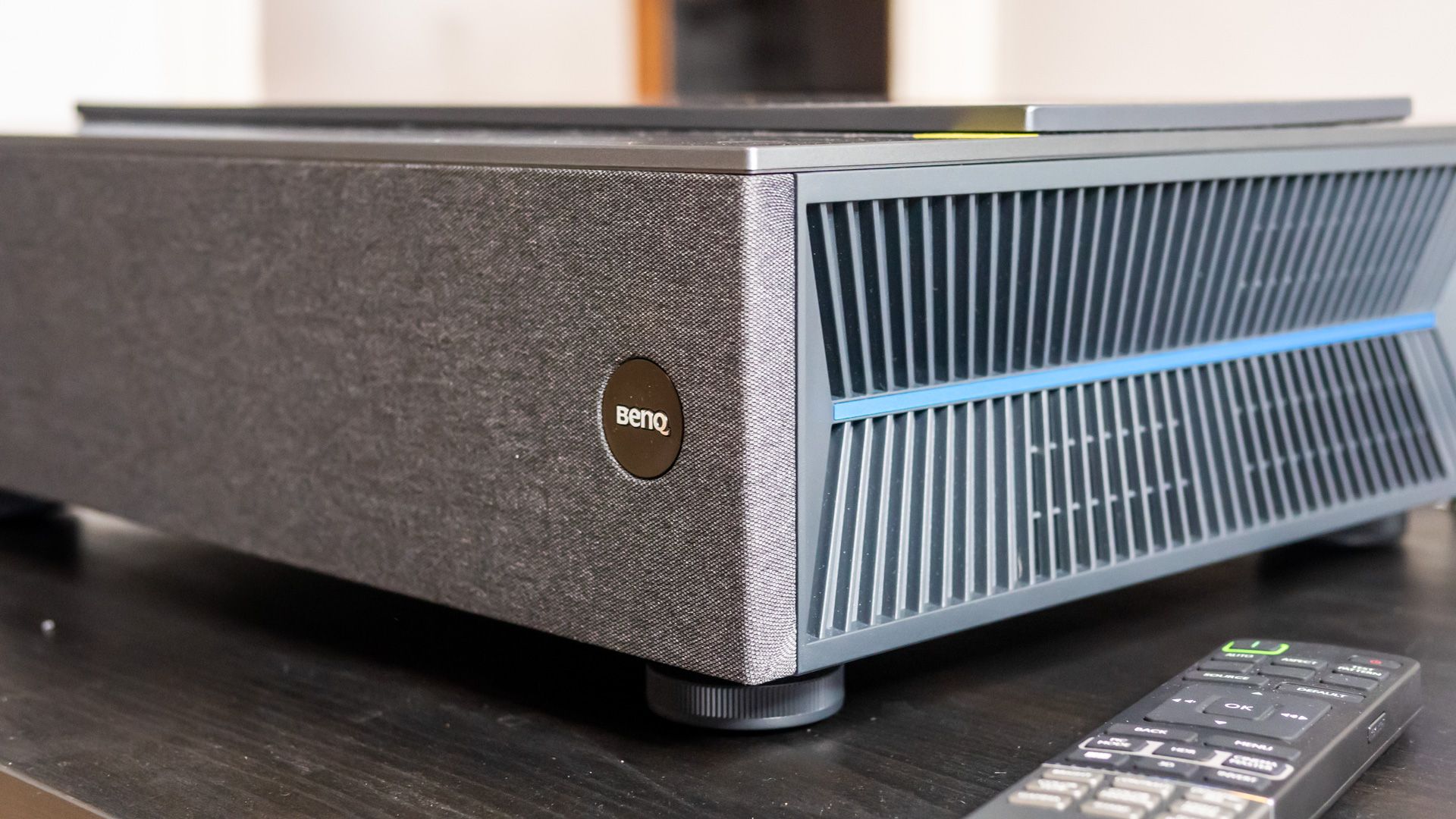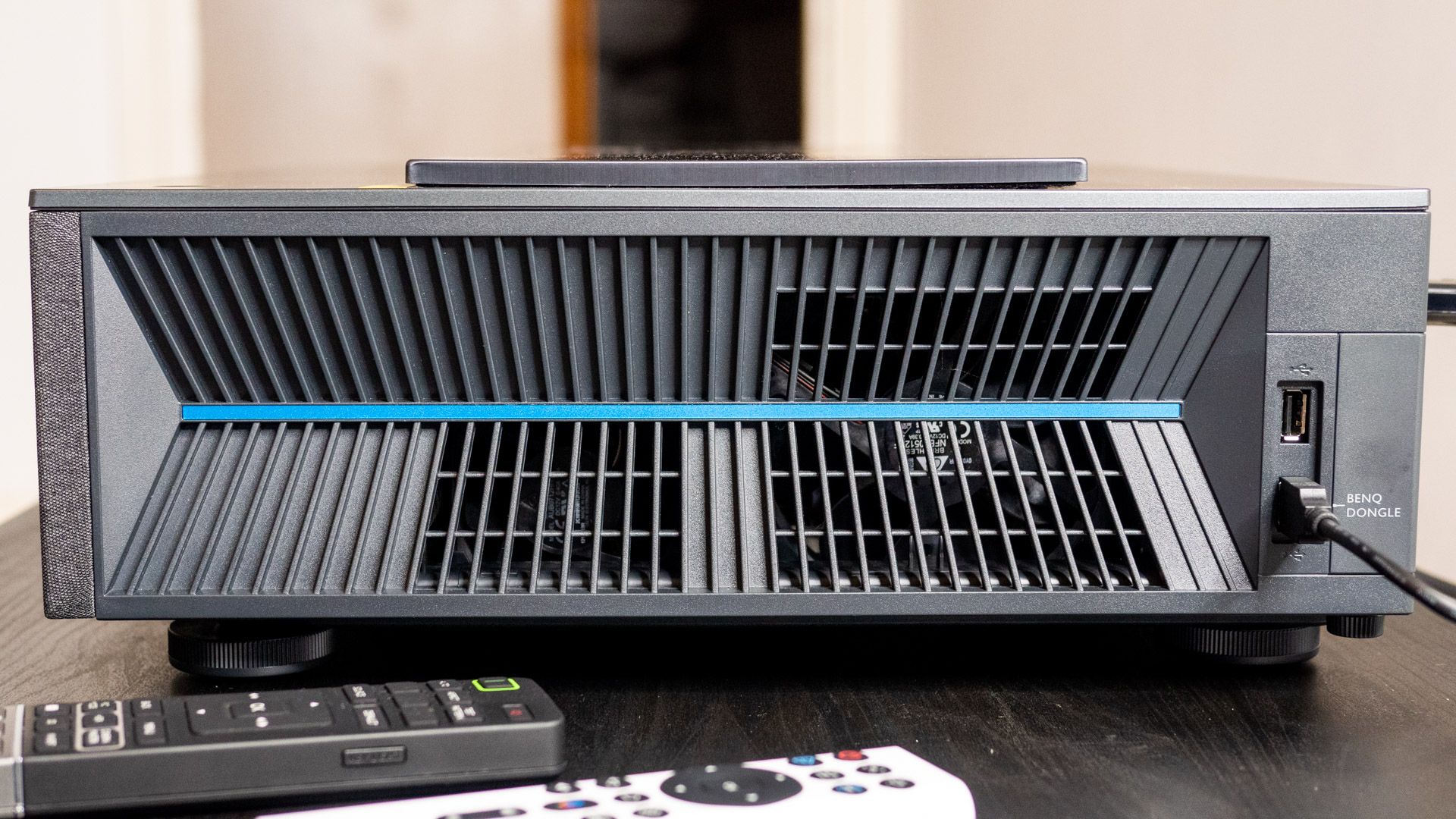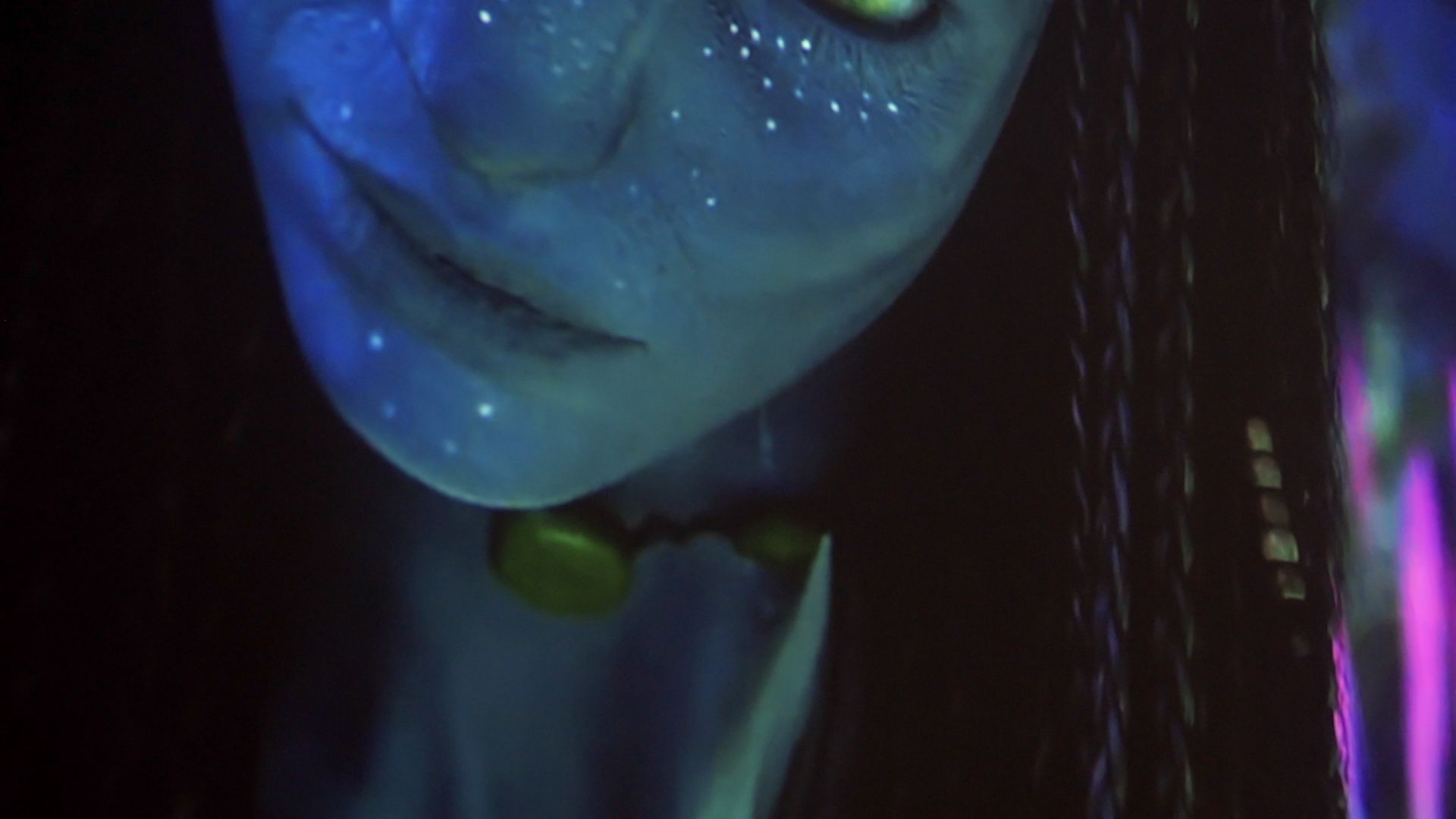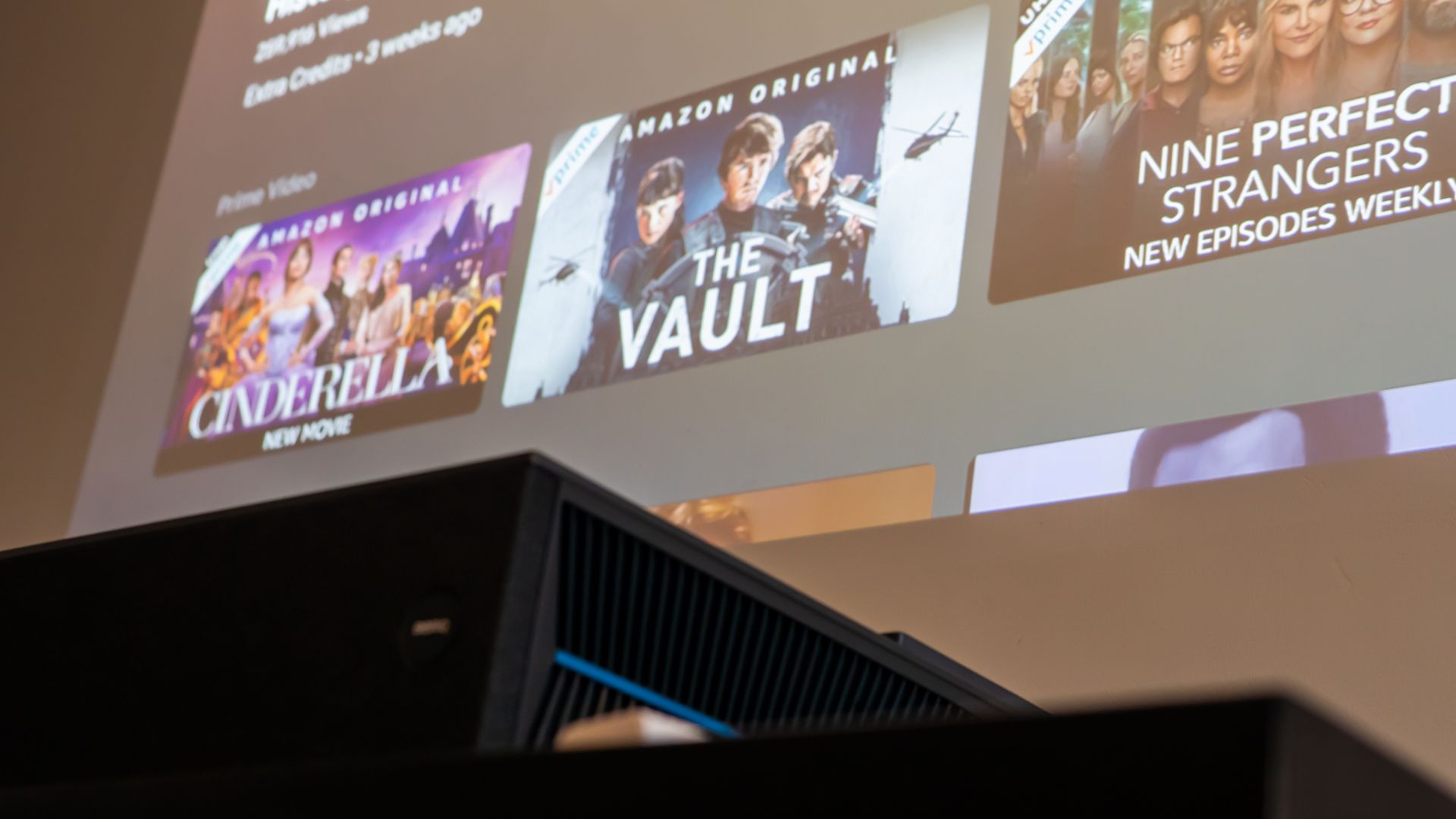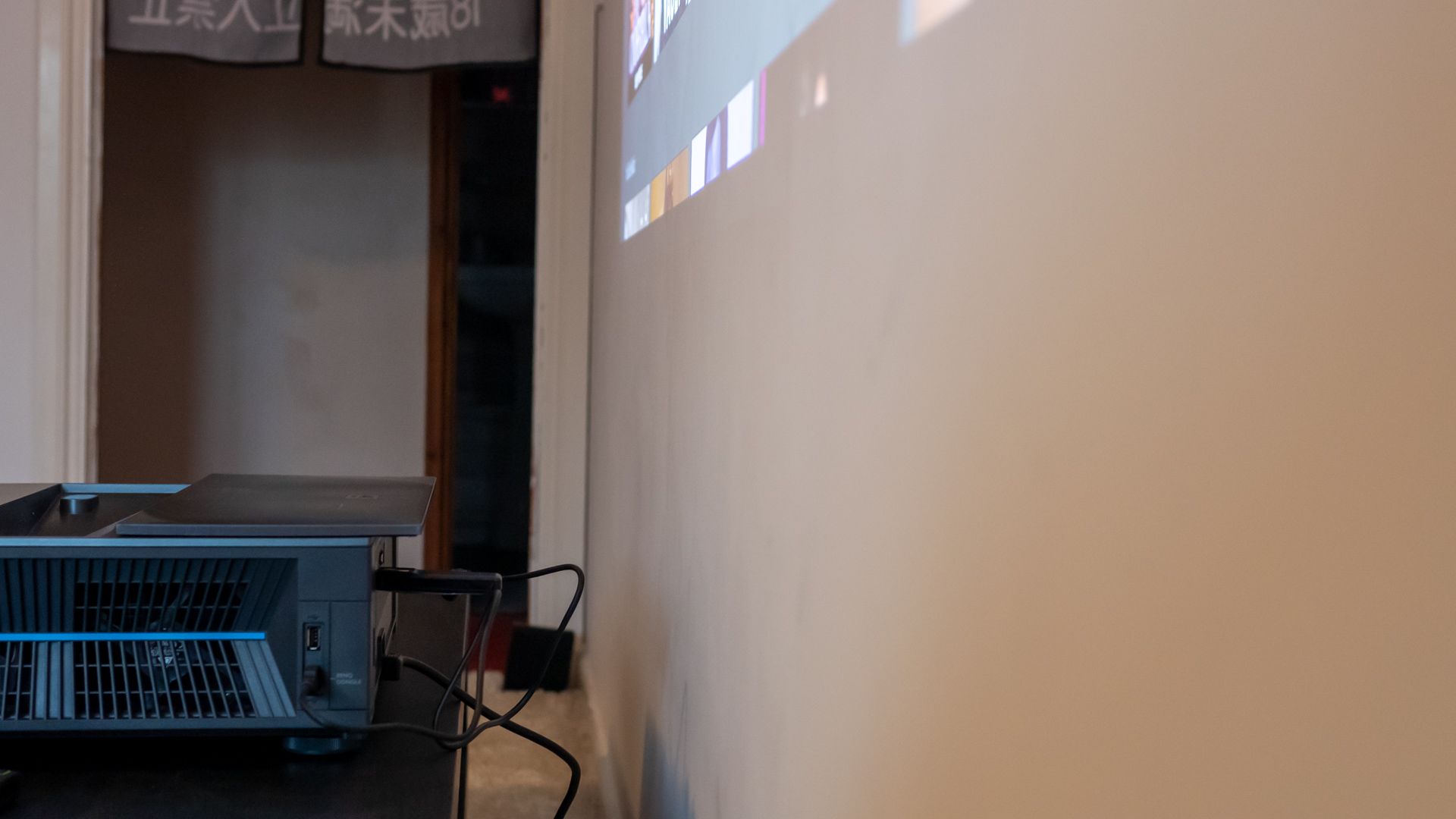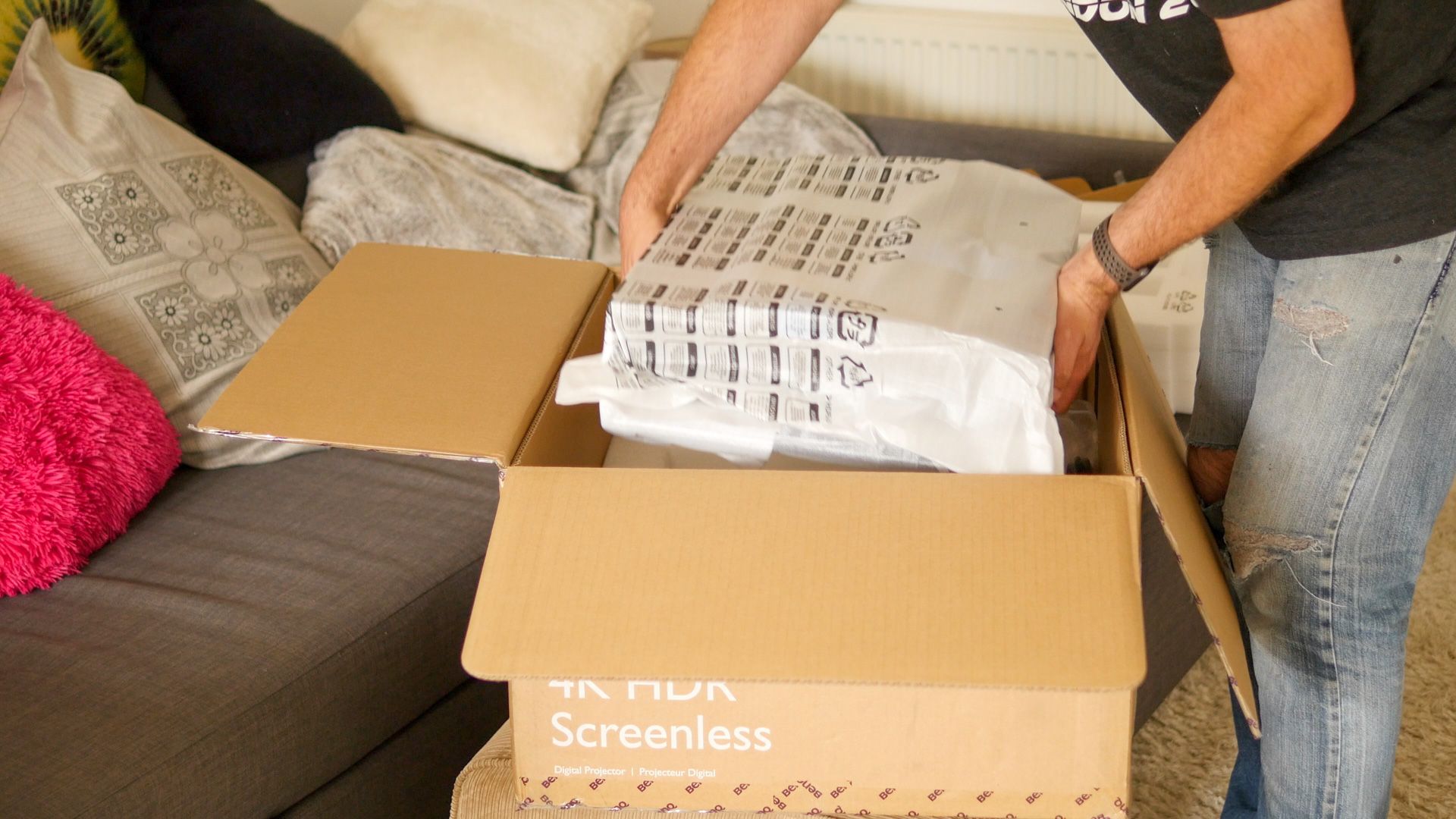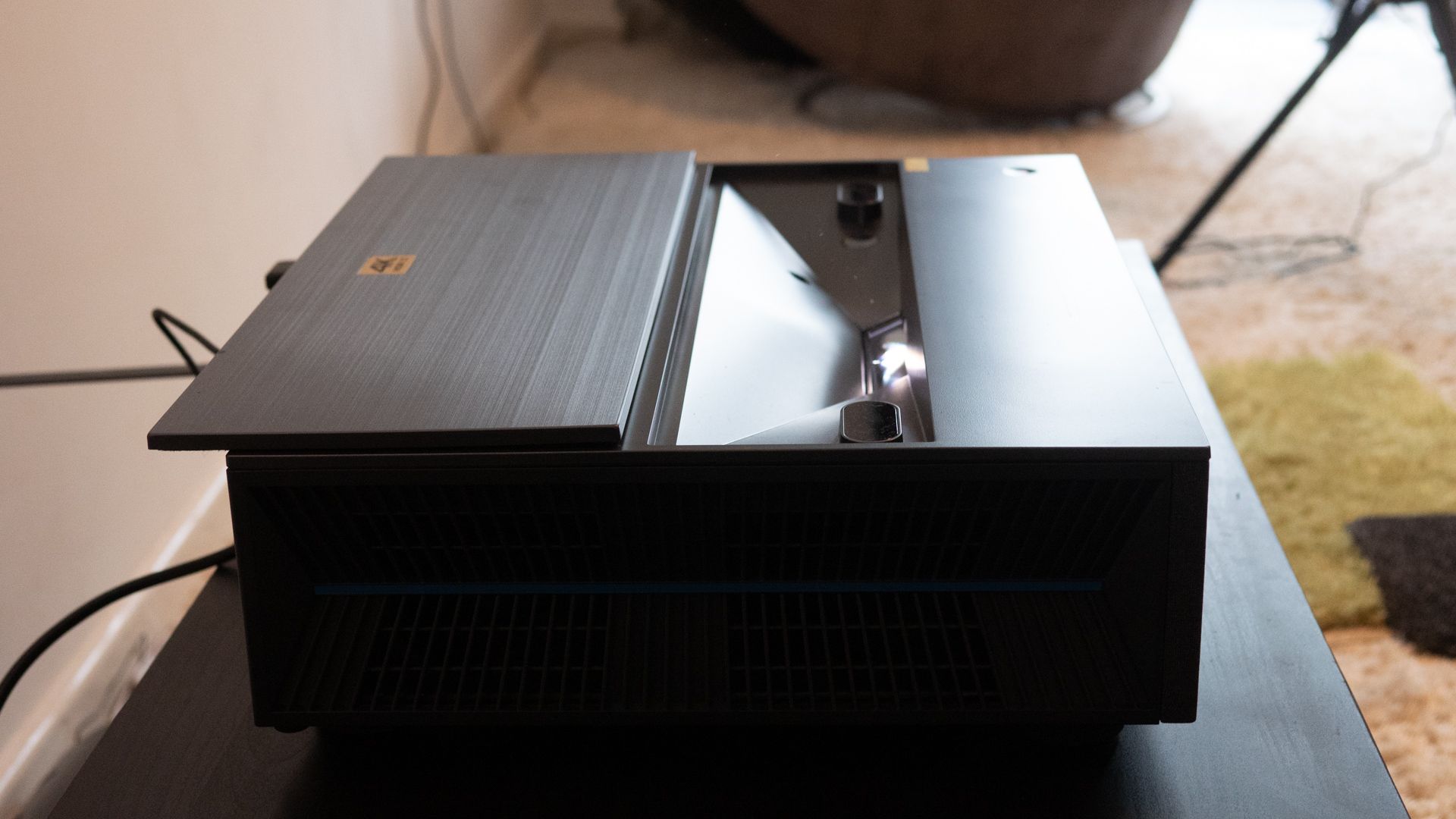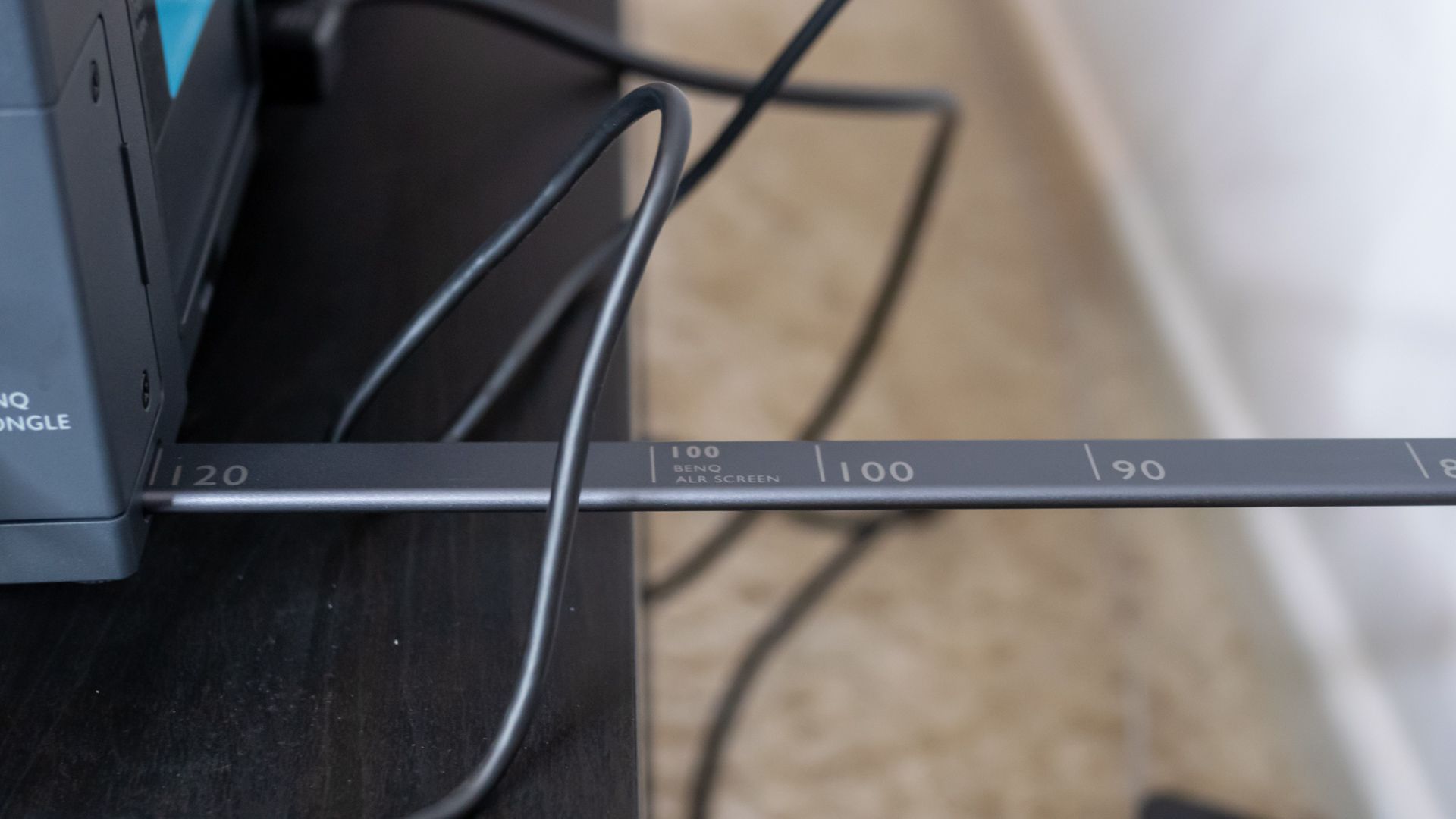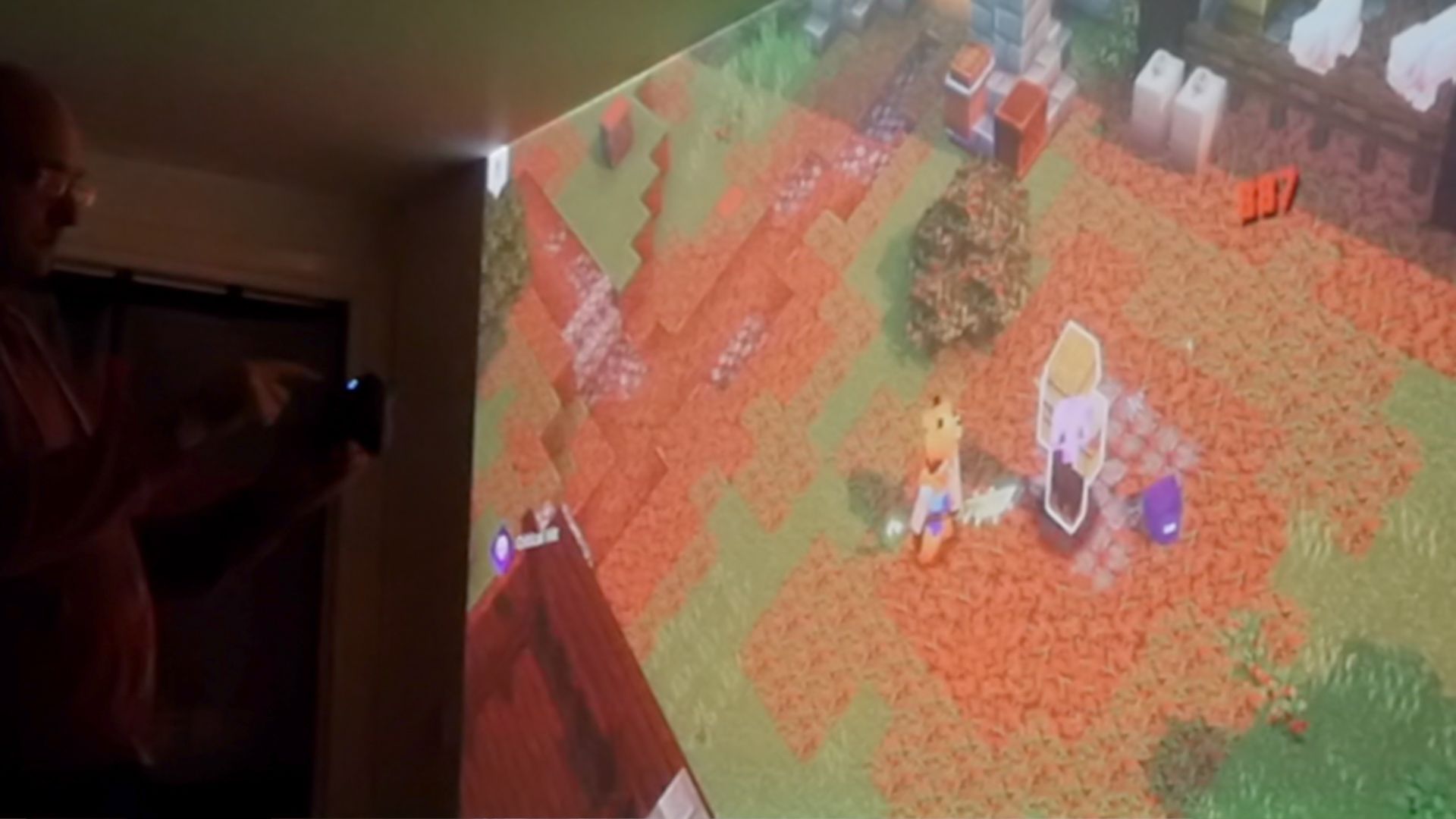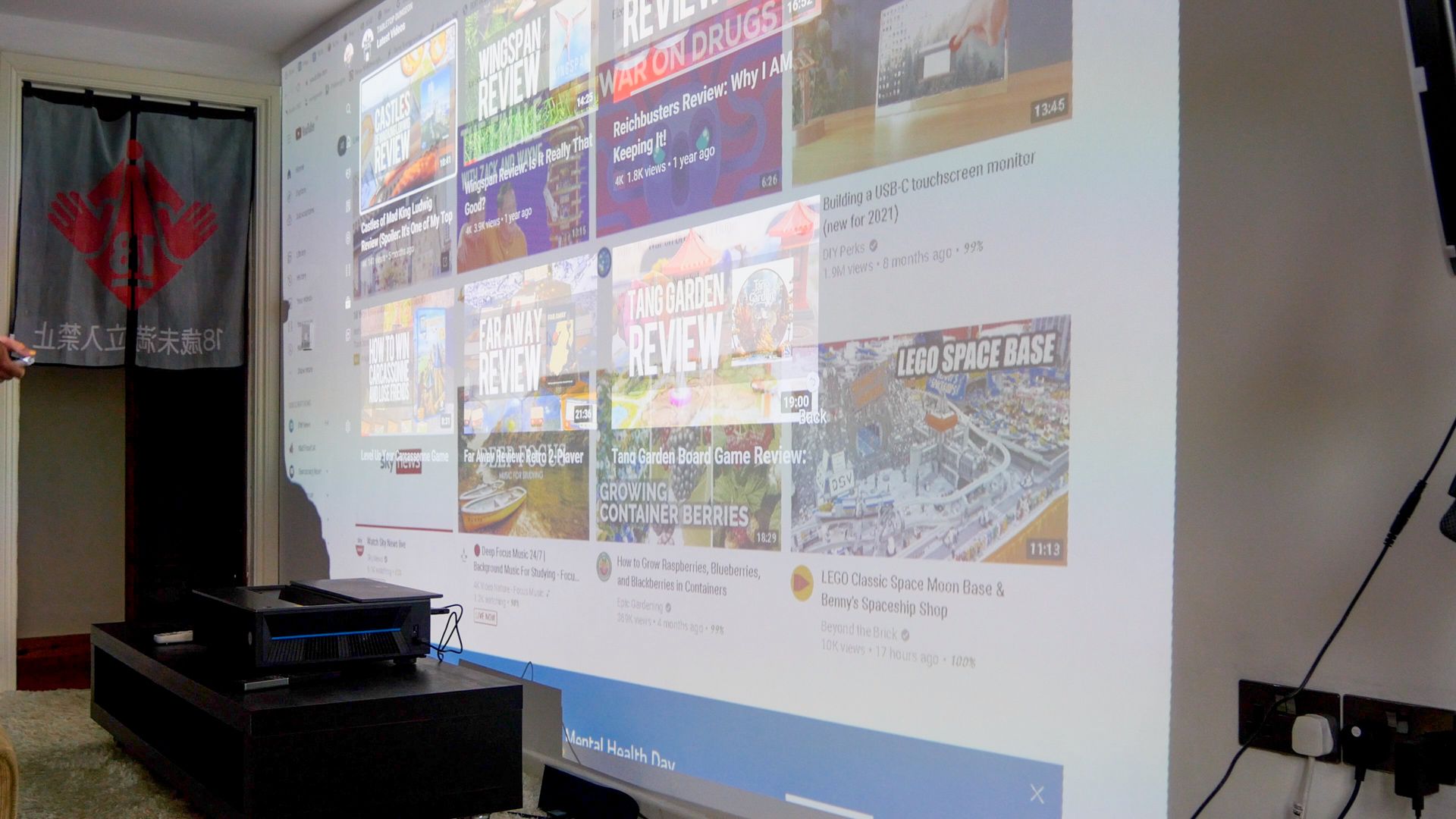BenQ V7050i
The BenQ V7050i produces the most visually stunning, bright, large-format home projections I've ever seen—even with non 4K HDR content, thanks to the gorgeous upscaling. But the 80ms input lag will be killer for gamers, and you can get a bigger projection from a cheaper, traditional DLP, mounted to your ceiling.
- Brand: BenQ
- Native Resolution: 4K
- ANSI Lumens: 2500
- Projection Technology: Laser
- Throw Ratio: UST (Ultra Short Throw)
- HDR: HDR10 and HLG broadcast support
- Audio: 2 x 5W built-in
- OS: Android TV streaming stick
- Lamp Life: 20,000 hours
- Mounting Type: Tabletop only
- 2500 ANSI lumens is bright enough for daytime use
- Helpful built-in ruler system for 80/100/120 inch screen
- Can be placed almost right next to your wall
- 4K resolution is crystal clear, corner to corner, even when pushed beyond the maximum screen size
- Incredible colors from HDR content
- Beautiful upscaling for 1080p content
- 80ms input lag makes it unsuitable for many game genres
- 120 inches will be the maximum screen size for most people
- Separate streaming stick can look messy, and uses up one of only two HDMI ports
I love the big screen. Not the actual cinema of course—that would involve leaving the house. I mean a home cinema. For me, nothing beats a huge screen for immersion in a movie or game.
In the past, this has meant mounting a projector to the ceiling, but now we're seeing so-called "laser TVs" that can project a huge 120-inch screen from a mere foot away from the wall. These are ultra-short-throw projectors; meaning that they only need a very short throw distance compared to the size of the image they project.
The BenQ V7050i is a high-end 4K HDR-capable cinema projector, retailing at around $3500—so is it right for your home cinema?
The BenQ V7050i Hardware
Laser projectors generally aren't small, but I was still taken aback by the size of the box it arrived in. The main unit is comparable to a small desktop PC, measuring L15.3 x W18.9 x H6.3 inches (39 x 48 x 16cm), and weighing around 22lbs (10kg). It's about twice the size of a typical DLP projector. The design is unexciting: it's a large dark grey box that looks much like a soundbar from the front. It also comes in white, if you'd rather (the V7000i model).
Upon first looking at this behemoth, you might be wondering where it actually projects from. Uniquely, the delicate parts of the V7050i are protected with a motorized retractable cover. While impressive to watch in action, I worry about the durability of a mechanism like that. Moving parts are often the first to break, and unlike say a cooling fan, this won't be an easy repair. That said, it comes with a three-year warranty.
Usefully, built into the rear of the device are two measuring sticks which show you exactly how far to place the projector from the wall in order to get a certain screen size of 80, 100, or 120 inches. It even includes a special mark for the 100-inch BenQ Air Screen, which this pairs well with.
As it common laser projectors, BenQ has included a proximity sensor close to the laser. This detects when people or pets are too close to the laser and deactivates it temporarily in order to not destroy your eyes.
Internally you’ll find a laser light source with a projected lifetime of 20,000 hours. That doesn't sound like a lot, but realistically, it's enough to watch a two-hour movie every day for 25 years. That sort of light source lifetime is similar to DLP projectors, however, the one crucial difference is that the laser isn't replaceable, unlike DLP bulbs.
As is typical even in this price range, the 4K is provided by DMD chip which uses pixel-shifting to essentially project a 1080p image four times, thereby giving the full 4K resolution. This is but a technicality of how most 4K projectors work; I don't say it to detract from the image quality of the V7050i at all, which is stunning.
Around the rear, you'll find two HDMI ports; one of which supports ARC (Audio Return Channel), and the other of which will be occupied by the included streaming stick. There are two USB ports on the side (again, one of which provides power to the streaming stick), and another at the rear. Finally, you can get audio out from the TOSLINK Optical port.
V7050i Image Quality
In terms of brightness, the stated 2500 ANSI lumens is more than sufficient for daytime viewing on the recommended screen size of up to 120-inches, though you'll always benefit from closing a curtain or two. I should note, I didn't use a projector screen for any of my testing. However, my walls are chalk painted, making a great projection surface that doesn't cause unnatural hotspots, as typical silk emulsions are prone to. This also meant I could push the V7050i well beyond the typical 120 inches.
The BenQ V7050i supports both HLG broadcast format and HDR10 cinema format, but not HDR10+ or the newer Dolby Vision. That's not really a problem though, since the format is backward compatible, so you'll still benefit from a High Dynamic Range regardless of what format it's in (just not to the fullest extent possible).
There's no denying that it looks incredible with 4K content. One concern I had was that projecting from such a short distance typically means some blurring toward the edges; this is just the nature of light refracting through an extreme lens. Not so: the V7050i was pin-sharp, corner to corner. When pushing beyond the recommended 120 inches though, I did have to use the motor focus option, accessible from the menu.
We rewatched Avatar in 4K HDR, renowned for its glowing fauna and fantastical landscapes; it's an amazing showcase film that really allows the V7050i to ... shine (sorry). It worked equally well for the mindless My Little Pony reboot. We also enjoyed marveling at our rapidly disappearing natural world in the BBC Life series. Color gradients were natural and smooth throughout, with no chromatic aberration, color banding, or other common projection quirks. For HDR content, you can choose between Bright Cinema mode, or Filmmaker mode, which is supposedly closer to what the director intended. In either case, I was blown away by the sharpness and color reproduction. Everything just looks incredible.
This superb image quality isn't just reserved for 4K HDR content, either, which is a personal worry I had about shifting to 4K. Is there any point to a 4K device if you don't have mountains of 4K Blurays to go with it? With the V7050i, absolutely. 1080p content is upscaled beautifully, looking sharper than ever—there's some serious magic going on inside here.
Unfortunately, that magic might also be what contributes to making the V7050i unsuitable for gaming.
Gaming on The BenQ V7050i? Not So Fast!
Naturally, I was eager to try out the BenQ V7050i for some glorious 4K gaming. We've spent many a lockdown weekend dungeon delving in Minecraft Dungeons with our 7-year-old son and 80-year old neighbor, so that was my first port of call. The blocky world might not be the best fit for the sharpness of 4K, but the vibrant colors of attacks and item effects certainly are. Unfortunately, I noticed an immediate difference to our usual sessions: everything felt like I was battling through a cloud of treacle. I scaled back to 1080p, assuming it was a bit too much for my machine to handle. No change. It was then that I realized there was some inherent lag going on here.
After investigating, it appears to be around 80ms of video latency, compared to 20ms or less on our usual DLP gaming projector. You can see this in slow motion on the review video (but note that the color refreshes are the result of recording at such a high frame rate).
Now to be fair to BenQ, the V7050i isn't specifically marketed as a gaming projector. In fact, there's even an FAQ entry on the sales page that mentions the delay:
V7000i/V7050i does not support low input delay crucial for first-person shooter and fighting games. For those types of games, we recommend the TK700STi, X1300i, and TH685i, which are projectors with low input delay capabilities.
But still, I can't help thinking that at this price range, there really ought to be the ability to cut out some of the image processing and force a low-latency mode. Cheaper systems have that capability, after all.
Precisely how much this matters to you is going to vary, but if you're playing anything at a competitive level, this isn't the projector for you. For what it's worth, I booted up Titanfall 2 as well, which I haven't been able to do in a long time because EA broke multiplayer for months. Because it was fresh for me, the latency wasn't nearly as noticeable. Though my average performance dropped from the top three to the bottom three, so perhaps it did have an unconscious effect.
Of course, for slower-paced games like Humankind, the 4K works incredibly well. The sharpness and richness of detail in the world enhances immersion, and again, it was the colors that really popped for me.
One particularly frustrating issue I found when gaming especially is that mode switching can take up to ten seconds. This can be lead to a vicious circle of cursing the world and everything in it if the game or Windows has popped up a dialog box asking if you'd like to keep the settings, which then times out before the mode switch has completed; which causes the mode to revert back again, for a further five to ten seconds, at which point you have to come up with some elaborate plan to guess which button you need to press to confirm or where to place the mouse cursor to click blindly. Grrrr.
Android TV
Confusingly, the box comes with two remote controls, one of which is for the main projector, and the other for an Android TV-based streaming stick. Rather than building an Android system into the projector itself, BenQ opted to separate the functionality, and include it in the purchase. While the cabling isn't as neat, this does mean that if you ever need to upgrade the streaming hardware or replace it, you can do so without changing the entire projector. When that sort of functionality is embedded into what should just be a display device, it can quickly become obsolete, or worse: a security risk. So it's great to see BenQ opted to separate these features.
Although two remotes can be confusing, the devices both support HDMI-CEC. You can bring up the projector menu from the dongle remote, but lose a few of the quick access buttons. Conversely, you can use the projector remote to navigate the Android TV menu, but don't have the media buttons or microphone input.
The Android TV interface will be instantly familiar, and I found the performance to be snappy to navigate and responsive. It also handled streaming 4K files through Plex effortlessly.
The only downside is that like many Android TV devices, it doesn't support Netflix natively. Instead, you'll need to use a PC web browser to cast a tab on the device. If Netflix is where you do most of your viewing, you'll likely want to invest in a different streaming stick. Thankfully you can do that, very easily, given it's not an integral part of the projector.
Built-In Audio
A grey mesh covers the front of the V7050i, under which sits a soundbar, consisting of a dual 5W tweeter and woofer. Although it happily decoded anything I threw at it, in reality, this isn't even a stereo speaker at the distance you would normally be sitting from it. The technical clarity of the sound produced is great, with clear vocals and punchy sound effects, but it's obviously lacking the sort of room-shaking bass you'd get from a separate subwoofer. I also found the overall level to be too low on occasion. With the volume cranked up full and kids snacking on popcorn, it left me wanting more.
I do have to wonder why it's there at all though. At this price point, no home cinema enthusiast would consider using a built-in projector speaker. It's just not comparable to even the most budget-grade 5.1 surround sound system.
Also on the subject of audio quality is fan noise; and in this case, it was so low as to be a non-issue.
Is The BenQ V7050i Right For You?
There's no denying that if you want the best image quality possible, the BenQ V7050i is right up there, bringing true cinema quality imagery right into your home. Giving this back and returning to the grey mush of my Optoma GT1080 is going to be very difficult.
But I also think it suffers from an identity crisis. It's not suitable for heavy gamers, with roughly 80ms of input delay. When asked, BenQ said they had no plans to implement a gaming mode to reduce the delay, but they would have more gaming-oriented ultra-short-throw models coming out imminently. So this is mainly for serious movie enthusiasts, then. Yet it includes a built-in speaker, which no home cinema fan is actually going to use. Is this a $3500 projector for people with immense living rooms who just don't like TVs, and would rather have the aesthetics of a grey box in front of their wall? If so, the streaming dongle sticking out the back and requiring USB power from the side is hardly ideal.
If I'm completely honest, I was also disappointed by the size of image possible from the V7050i, but that's a criticism of any ultra-short-throw laser projector rather than V7050i specifically. These types of projectors can get a relatively large image from a short distance, but in order to do so, they project diagonally upwards. Unfortunately, I'm used to projecting onto my entire wall space—top to bottom—from a rear projection short-throw DLP system.
You can see the size difference in the image below, at the 120-inches recommended maximum from the V7050i versus the full wall projection from an Optoma GT1080.
With the BenQ V7050i sitting on a TV stand, the image is about half as tall as a result. I ended up doing most of my testing with the V7050i on the floor, and it still couldn't project as big. If you have taller ceilings, this might not be an issue, but I don't, and nor do I particularly like staring that far upwards. And if you're only going to project an 80-inch image, I'm not sure why you're buying a projector instead of an actual TV.
So the upshot is: if you're after a laser "TV" for your living room with the best image money can buy, and aren';t a hardcore gamer, the V7050i is it. Even the real world doesn't look this good! But if you want an absolutely massive screen, despite the term "ultra-short-throw", a laser projector may not be right for you. The best option is instead a short-throw DLP projector, mounted on the ceiling at the back of your room. That doesn't mean you need a huge room; mine is barely three meters from sofa to wall. You can still get 4K HDR short-throw projectors (such as the BenQ TK700STi, in fact), and they're more suited to gaming.

